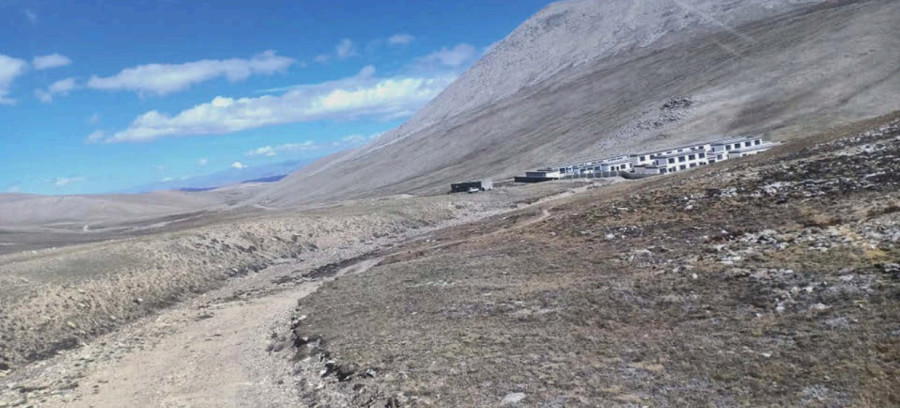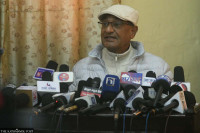National
A missing border pillar in Humla creates row between Nepal and China
Both sides claim that an area where Chinese have erected 11 buildings fall within their territory. Several years ago there were only two buildings there.
Anil Giri
Nepal and China are engaged in a boundary row in Humla after the Chinese side allegedly built 11 buildings in a remote part of the district that Nepal claims as its own territory.
With a border pillar missing since Nepal built a road in the area several years ago, China has now constructed some buildings.
There was just a hut in the area in 2005, according to Dattaraj Hamal, assistant chief district officer of Humla who visited the disputed area recently.
“I talked to the people there and reported to the chief district officer,” Hamal told the Post over the phone from Humla. “He in turn reported to the Home Ministry. He now has gone to the area as per the Home Ministry’s instructions.”
Hamal had visited the area after people from Namkha Rural Municipality reported to the district administration office about the construction of nine new buildings by the Chinese security and border forces in the area.
“The Chinese side claimed that the area where the houses are built falls within the Chinese territory,” said Bishnu Bahadur Tamang, chair of Namkha Rural Municipality, who reached the area on Sunday, along with the team of officials led by Chief District Officer Chirinjbi Giri.
During the inspection by the Giri-led team, Chinese security officials also claimed that Chinese territory extends one kilometre further south from where the buildings are located.
According to Tamang, Nepali land, however, extends two kilometres north from where the buildings are.
“Of the 11 houses in the disputed area, security forces live in one and the others are empty,” he said.
Following Hamal’s visit to the area, the Home Ministry dispatched a team of government officials, head of security agencies and local government representatives of Humla district to Lapcha in Ward No. 6 of Namkha Rural Municipality to inspect and report back to the ministry. The report is expected at the end of the week.
Chakka Bahadur Lama, a Member of Parliament from Humla, said that the dispute has emerged after pillar number 11 went missing.
The number refers to the count of the pillar on the Nepal-China border starting from the west.
“As long as both sides do not ascertain the location of the missing pillar, the dispute will continue,” Lama told the Post. “The pillar was damaged during a road construction on the Nepali territory some 12 years back. That area where the Chinese have allegedly built the concrete buildings is on the old yak caravan route used for trade between Nepal and Tibet.”
During a meeting between the two sides in 2015, Nepal and China had agreed to ascertain the location of the missing pillar, but no steps were taken in that regard, according to Paljor Tamang, chair of Ward No 6 of the rural municipality where the disputed area lies.
While it is not possible to erect pillars everywhere along the border between Nepal and China given the difficult geographic terrain, there are no such problems where pillars numbering 11, 12 and 13 lie, according to an official of the Ministry of Land Management.
“The pillar can be traced,” the official told the Post who wished to remain anonymous citing sensitivity of the matter.
Tamang, the chair of Namkha Rural Municipality, said that if a straight line of demarcation from pillar no 12 towards 11 is drawn, the disputed land clearly falls inside Nepali territory.
Lawmaker Lama blames the negligence on the part of the Nepali government for the problem as Nepal’s security presence in the border area is much less than that of the Chinese side.
Senior officials at the Ministry of Land Reform and Management also said that this is the result of failing to inspect the border on a regular basis.
“A detailed boundary inspection has not happened along the northern border since 2005,” said the official at the ministry. “A similar kind of dispute surfaced some five years back regarding pillar no 12 but it was later sorted out.”
Such an inspection usually happens every 10 years.
After Nepali officials reached the disputed site on Sunday, a team of Chinese security personnel arrived in a truck, a tanker and a jeep. They were wearing personal protective equipment and used a microphone to talk with Nepali officials and asked them to go to the border for talks, according to Tamang.
“We spent around one and a half hours at the disputed area. After we reached, a team of Chinese army and security officials came and said talks cannot be held on their territory. Then we left,” Tamang told the Post from the district headquarters over the phone. “We claimed that area to be our territory, they showed us the map and said it is theirs.”
In an email response, the Chinese embassy in Kathmandu on Tuesday evening said that it had to check with its “headquarters”, although it was aware of media reports on the issue.
“We are aware of those news first spread by some Indian media and now it has also already drawn Nepali media's attention,” said Zang Si, spokesperson for the Chinese Embassy earlier in the evening.
Later in the evening, Zhang, in another email, said, “I have just got feedback from our headquarters. The buildings that are mentioned by the media are in the Chinese side [sic]. Nepali side can check it again.”
Officials at the Ministry of Home Affairs told the Post that they are waiting for the report from Humla to be submitted by Chief District Officer Giri.
“We are waiting for the report from Humla so until the report comes, we cannot make any comments,” Chakra Bahadur Buda, spokesperson for the Home Ministry, told the Post. “This is a sensitive issue and without verifying it, we cannot say anything now. A team of government officials has visited the area and it will submit the report based on their findings. First we have to verify whether it was an encroachment or not. If it is, then we will take it up diplomatically.”
In his second email, Zhang said if the Nepali side has any questions, they can be looked into.
“China and Nepal are good neighbors and friends. We always respect Nepal's sovereignty, integrity and independence. If Nepali side have any questions, we can check together [sic],” said Zhang. “I want to emphasize that there are no border dispute between China and Nepal, any border issues can be solved through friendly negotiation [sic].”




 9.12°C Kathmandu
9.12°C Kathmandu













%20(1).jpg&w=300&height=200)

